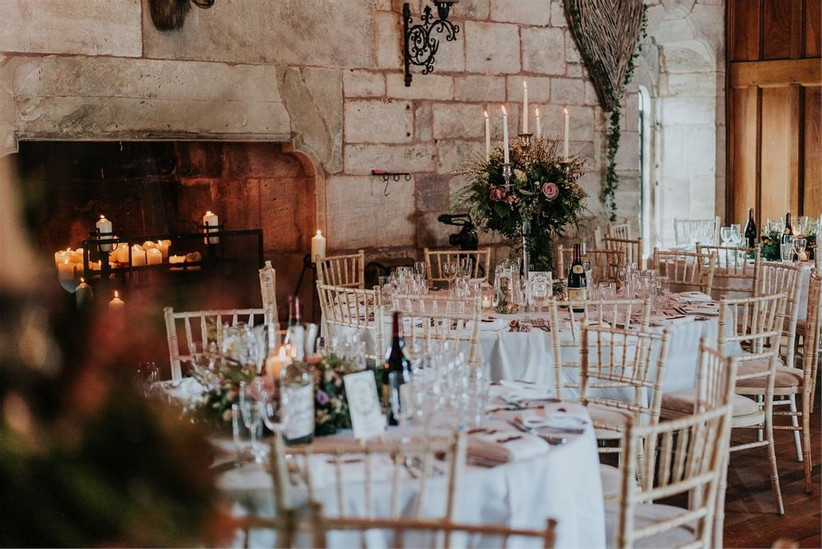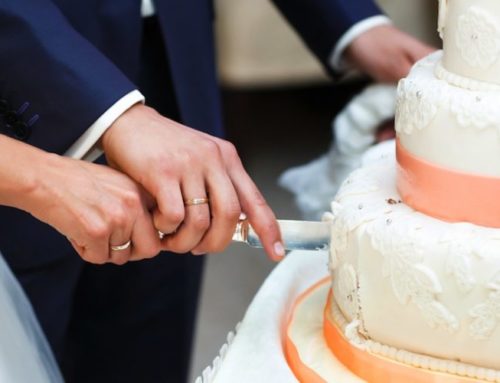Table layouts
The reception room table layout will depend upon the shape of the tables your venue provides and how the tables are best arranged to make the room look
balanced for the number of guests to be seated. Round tables, for example, give a much more pleasing and spacious look than two or three long tables that join to the top table.
A typical reception table layout (shown left) will have one long top table for the bridal party and as many round tables as required for your guests.
A round top table should be avoided if possible because the view of the bride and groom will be obscured by others on the table and several of the bridal party will have their backs to the other guests. A small table placed to one side of the top table is ideal for displaying the cake in its full glory!
Guest seating arrangements
Your close family and friends should be seated nearest the top table with other relatives and friends sitting further away. If you have round tables, guests with partners are usually seated side by side. If you choose to have long tables, partners are usually seated opposite each other. It is customary to alternate male and female guests. If you decide to split up couples, they should not be too far away from each other. Children should always be seated with their parents.
You should ensure as much as possible that your guests sit with people that are known to each other as this will make them feel more comfortable and facilitate good conversation. Although this will not be possible in all cases, at least try to have similar age groups or guests with similar interests seated together such as aunts and uncles, friends, work collegues etc. Guests may be very uncomfortable if they are seated with people they do not know. It is particularly important to bear this point in mind if you have round tables, because the temptation is to fill up the tables with unconnected guests.
Printed table plans
So that guests can easily find their places, a printed table plan positioned just inside the reception room will be very helpful. You may also wish to place a printed seating plan in the pre-reception drinks area. The most efficient form of table plan is where guests’ names are listed alphabetically with their table number printed alongside their name. An adjacent map showing the physical table layout with the table numbers marked allows guests to locate their table quickly.
As an alternative to numbering your tables, why not give each table a name, particularly if you have a theme running through your wedding. Alternatively, you might wish to name your tables after people or objects relating to an interest or hobby you both share or name each table after a poet and have a love poem written by the poet left on each table. We have a very good selection of poems and readingsassociated with love and marriage from which to choose if this idea appeals to you.
Table place cards
To ensure guests sit at the correct seat, table place cards should be used. They can either be flat for placing in card holders or fold tent-like to be free-standing. The style of address for place cards should match the style written on your wedding invitations. If your invitations were written in the formal, traditional style of, for example, Mr. and Mrs. David Smith, the place cards should show Mr. David Smith on one card and Mrs. David Smith on another. Less formal place cards, where the invitation was written in the style of, say, David and Sarah Smith, should simply have David Smith written on one card and Sarah Smith on another. As with the names on wedding invitations, place cards should be hand written. Specialist wedding stationery companies can provide printed table plans and
table place cards to co-ordinate with your wedding stationery.
The bridal party entrance
Once your guests have passed along your receiving line, they will move into the reception room and make their way to their tables. If you have engaged a master of ceremonies, your entrance will be announced and your guests asked to stand. The bridal party then enters the room to take their places at the top table (even if you are only having a buffet meal, it is usual to have a top table reserved for the bridal party). The bridal party is led by the bride and groom walking side by side, followed by the bride’s father with the groom’s mother; the bride’s mother with the groom’s father and the best man with the chief bridesmaid. Your guests are seated once the bridal party are seated.
Top table seating arrangements
Deciding who sits on the top table can be a straight forward matter if both sets of parents have conventional relationships. However, problems can arise when there are separations, divorces or tension between people you would like to include on your top table.
However, by following established tradition, the decision-making process can be simplified. Traditionally, the wedding party, who sit at the top table, comprise the bride and groom, the bride and groom’s natural parents, the best man and chief bridesmaid. Even where the parents are separated, remarried or divorced, it is still usual for only the natural parents to sit at the top table. Other family members, such as step-parents, are not part of the traditional bridal party but are treated as honored guests. As honored guests, they should be given importance by being seated on a table close to the top table. Having an honored guests’ table also solves the problem of where to sit bridesmaids and ushers. Since these helpers are also honored guests, they would join step-parents, and partners of separated parents, on this special table – although young bridesmaids and page boys should sit with their parents.
Seating arrangement for the traditional bridal party:
Chief
Bridesmaid Groom’s
Father Bride’s
Mother Groom Bride Bride’s
Father Groom’s
Mother Best Man
Should you decide, for whatever reason, to have a different seating arrangement to the above, there are a few points worth mentioning. It is usual for the bride and groom to sit in the middle of the top table – with the bride seated to the left of the groom – and for the gender of those seated to alternate. It is also generally accepted that the hosts of the wedding, whoever they are, sit at the top table.
In the case of divorced or separated parents, where you are unsure of their reaction, the best course of action is to first ask them what they would like to happen;
If the parents of the bride (or groom) are hosting the wedding, despite their separation, they may be happy to sit at the top table without their partners thus avoiding having too many people on the top table.
If they have not remarried, or do not have a current partner, they may be happy to sit alone or be accompanied by another relative such as a sibling or child.
If they have a new partner and the relationship is generally recognized, they may like to sit with their new partner.
In the case of parents whose spouse has died, again ask them what they would prefer to do. They may feel that they would like some moral support at the top table. If the bride is being given away by someone other than her father, that person may be of comfort to the mother of the bride. Otherwise, perhaps a brother, sister or grown-up child of the single guest could be included on the table.
You may find that your wishes and those of your parents and others are similar, or that everyone is happy to go along with your decisions and the wishes of each other. If this is the case, find a solution you are all happy with and go for it. If a simple agreement cannot be found, it is down to the bride and groom to decide the course of action they would like to take, and then ask the guests to comply. It would not be unreasonable to ask those who have differences to put them aside for just one day!
Always bear in mind that the number of guests on your top table is, ultimately, a matter for you to decide. It is possible that there could be twelve or more people at your top table, if all parents have new partners, or as few as four if you decide to solve the problems by sitting at your top table with just the chief bridesmaid and best man.
There are a variety of ways the bridal party can be arranged on the top table. Here are a few alternative suggestions:
Bride and groom’s parents still married and speaking
(alternative to the traditional seating arrangement):
Groom’s
Mother Bride’s
Father Chief
Bridesmaid Groom Bride Best Man Bride’s
Mother Groom’s
Father
Bride’s parents divorced and remarried:
Bride’s
Stepfather Chief
Bridesmaid Groom’s
Father Bride’s
Mother Groom Bride Bride’s
Father Groom’s
Mother Best
Man Bride’s
Stepmother
Groom’s parents divorced and remarried:
Best Man Groom’s
Stepmother Groom’s
Father Bride’s
Mother Groom Bride Bride’s
Father Groom’s
Mother Groom’s
Stepfather Chief
Bridesmaid
Both sets of parents divorced and remarried:
Groom’s
Step-mother Bride’s
Step-father Chief
Bridesmaid Groom’s
Father Bride’s
Mother Groom Bride Bride’s
Father Groom’s
Mother Bride’s
Step-mother Groom’s
Step-father
Tension between bride and groom’s parents:
Chief
Bridesmaid Bride’s
Father Bride’s
Mother Groom Bride Groom’s
Father Groom’s
Mother Best Man
If the above examples do not suit your requirements, use them as templates to create a seating arrangement suitable for your particular circumstances.
Top table too complex?
If, because of second spouses, step-parents or inter-family friction, your top table seating arrangement is too complex or impossible to get right, you could consider an alternative seating arrangement where couples from the bridal party each host a separate table (preferably round tables).
“In eu ultricies lacus. Phasellus non ante nec neque imperdiet congue. Donec sed lectus eu mi tincidunt rhoncus non a metus. In hac habitasse platea dictumst”
Nam lorem mauris, scelerisque nec iaculis id, dignissim a tortor. Quisque in arcu in tellus facilisis venenatis vitae finibus tortor. Nullam vestibulum venenatis auctor. Suspendisse potenti. Class aptent taciti sociosqu ad litora torquent per conubia nostra, per inceptos himenaeos. Quisque id consequat tortor. Sed et commodo diam. Curabitur bibendum nunc ut finibus tempus. Aenean eu dui sed eros maximus vulputate. Praesent vitae ullamcorper nibh. Donec bibendum, odio ut aliquam faucibus, ipsum felis blandit dolor, in dignissim.
Praesent posuere ante
Ut vitae lobortis magna, id viverra orci. In eget scelerisque nibh, nec suscipit lacus. Cum sociis natoque penatibus et magnis dis parturient montes, nascetur ridiculus mus. Aliquam pulvinar ipsum augue, tempor luctus felis malesuada venenatis. Vestibulum sit amet imperdiet risus. Etiam eget vehicula metus, ac vehicula libero. Aliquam et viverra urna. Vivamus elementum porta lectus.

